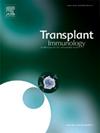Effective management of primary central nervous system posttransplant lymphoproliferative disorder in a kidney transplant recipient using surgery and rituximab, along with a literature review
IF 1.6
4区 医学
Q4 IMMUNOLOGY
引用次数: 0
Abstract
Background
Primary central nervous system post-transplant lymphoproliferative disorder (PCNS-PTLD) is a rare but severe complication following solid organ transplantation (SOT). Currently, treatment regimens still lack clear guidelines.
Methods
A kidney transplant recipient with PCNS-PTLD was reported in this case study, who treated with rituximab after transplant surgery. What's more, PubMed was used to find case series related to PCNS-PTLD.
Results
The patient of this case report experienced complete remission (CR) following resection and treatment with rituximab. A total of 130 cases were extracted from 20 articles and were combined with one case from our institution. Out of 131 patients with PCNS-PTLD, the median duration between SOT and PTLD was 48 months. The majority (83 %) of patients had received a kidney transplant, with 74.8 % showing monomorphic histology and 93 % having an EBV+ tumor. Most patients (95 %) had reduction in immunosuppression as part of their first-line treatment. Other initial treatments consisted of high-dose methotrexate (HD-MTX) (46 %), high-dose cytarabine (HDAC) (26 %), and/or rituximab (47 %). The Overall Response Rate (ORR) was 63 %, showing that HD-MTX and/or HDAC-based therapy had the highest rates of ORR and CR. Roughly half of the participants experienced prolonged survival. After 36 months of observation, the median progression free survival (PFS) was 10 months and the overall survival (OS) was 18 months.
Conclusion
The use of HD-MTX and HDAC showed promise in treating PCNS-PTLD, but rituximab may also a potential drug for the PCNS-PTLD. Research should continue to investigate the alternative treatments for this condition.
应用手术和利妥昔单抗有效治疗肾移植受者原发性中枢神经系统移植后淋巴增生性疾病,并附文献综述。
背景:原发性中枢神经系统移植后淋巴细胞增生性疾病(PCNS-PTLD)是实体器官移植(SOT)后罕见但严重的并发症。目前,治疗方案仍然缺乏明确的指导方针。方法:本病例研究报告了一例肾移植术后接受利妥昔单抗治疗的pns - ptld患者。此外,PubMed还用于查找与PCNS-PTLD相关的病例序列。结果:本病例报告的患者在切除和美罗华治疗后完全缓解(CR)。从20篇文章中提取130例,并结合我院1例。在131例pns -PTLD患者中,SOT和PTLD之间的中位持续时间为48 个月。大多数患者(83 %)接受过肾移植,其中74.8% %表现为单形态组织学,93 %为EBV+肿瘤。大多数患者(95% %)作为一线治疗的一部分,免疫抑制有所减少。其他初始治疗包括高剂量甲氨喋呤(HD-MTX)(46% %)、高剂量阿糖胞苷(HDAC)(26% %)和/或利妥昔单抗(47% %)。总缓解率(ORR)为63 %,表明HD-MTX和/或hdac为基础的治疗具有最高的ORR和CR率,大约一半的参与者延长了生存期。经过36 个月的观察,中位无进展生存期(PFS)为10 个月,总生存期(OS)为18 个月。结论:HD-MTX联合HDAC治疗PCNS-PTLD具有良好的疗效,但利妥昔单抗也可能是治疗PCNS-PTLD的潜在药物。研究应继续探讨这种情况的替代治疗方法。
本文章由计算机程序翻译,如有差异,请以英文原文为准。
求助全文
约1分钟内获得全文
求助全文
来源期刊

Transplant immunology
医学-免疫学
CiteScore
2.10
自引率
13.30%
发文量
198
审稿时长
48 days
期刊介绍:
Transplant Immunology will publish up-to-date information on all aspects of the broad field it encompasses. The journal will be directed at (basic) scientists, tissue typers, transplant physicians and surgeons, and research and data on all immunological aspects of organ-, tissue- and (haematopoietic) stem cell transplantation are of potential interest to the readers of Transplant Immunology. Original papers, Review articles and Hypotheses will be considered for publication and submitted manuscripts will be rapidly peer-reviewed and published. They will be judged on the basis of scientific merit, originality, timeliness and quality.
 求助内容:
求助内容: 应助结果提醒方式:
应助结果提醒方式:


